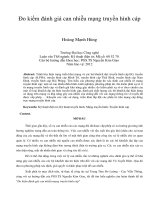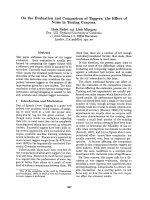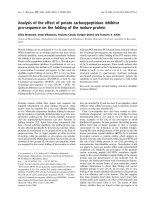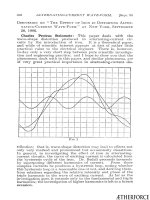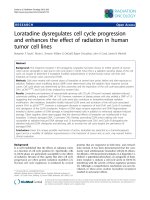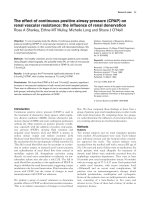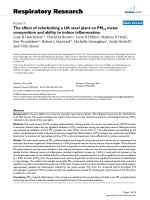The effect of chromium in textile industry waste on soil quality in karanganyar indonesia
Bạn đang xem bản rút gọn của tài liệu. Xem và tải ngay bản đầy đủ của tài liệu tại đây (2.9 MB, 66 trang )
THAI NGUYEN UNIVERSITY
UNIVERSITY OF AGRICULTURE AND FORESTRY
AYU MONICA ENDRINA
TOPIC TITLE :
THE EFFECT OF CHROMIUM IN TEXTILE INDUSTRY WASTE ON SOIL
QUALITY IN KARANGANYAR, INDONESIA
BACHELOR THESIS
Study Mode : Full-Time
Major
: Environmental Science and Management
Faculty
: International Programs Office
Batch
: 2014 – 2017
Thai Nguyen, November 2017
1
DOCUMENTATION PAGE WITH ABSTRACT
Thai Nguyen University of Agriculture and Forestry
Degree Program :
Bachelor of Environmental Science and Management
Student Name :
Ayu Monica Endrina
Student ID :
DTN1454290080
Thesis Title :
THE EFFECT OF CHROMIUM IN TEXTILE
INDUSTRY WASTE ON SOIL QUALITY IN
KARANGANYAR, INDONESIA
Foreigner Supervisor (s):
Prof. Dr. Samanhudi, S.P, M.Si.
Dr. Ir. Margaretha Maria Alacoque Retno Rosariastuti,
M.Si.
Vietnamese Supervisor
Dr. Hồ Ngọc Sơn
Abstract: Chromium exists in the environment in several diverse forms such as, Cr
(III), and Cr (VI). Cr toxicity depends on its valence state. Cr (VI) which is
regarded as being highly mobile is toxic, while Cr (III) is less mobile and less
toxic. Cr (VI) being more mobile in soil, more toxic and a stronger oxidant
penetrates more readily into the cell membranes than the trivalent form. Chromium
affects to the soil pH, N total of the soil, and also K exchangeable. This study was
conducted by taking samples from five locations (Soil from the field, water bodies
and irrigation), which four locations were in a location in textile industries area
surrounding them such as Macanan, Getas, Waru, Ngringo and one location was in
a location with no textile industry such as Karangpandan. After obtaining the
sample we analyzed soil chemical characteristic (pH, N total, P available, K
exchangeable, C-organic, electric conductivity and cation exchange capacity) in the
Laboratory of Chemistry and Soil Fertility, also about biological characteristic
(indigenous bacteria and fungi) in the Laboratory of Soil Biology and
Biotechnology. The data were analyzed by statistical analysis using T-test 95%,
2
and tested the correlation to see the effect of chromium on soil quality. The result
of this research is at five sampling sites, soil at five locations contain the chromium
content. Three locations contain chromium exceeds the threshold (>2.5 µg.g-1) ie
Getas (5.21 µg.g-1), Karangpandan (3.23 µg.g-1), Ngringo (3.06 µg.g-1) and two
sites have chromium content below the permitted threshold (<2.5 µg.g-1) ie
Macanan (2.27 µg.g-1) and Waru (2.02 µg.g-1). Karangapandan area which there’s
no industrial factory still contaminated above the threshold, allegedly due to
excessive chemical usage such as fertilizer and pesticide. The amount of chromium
in the soil will influence to pH of the soil, N total, K exchangeable and also impact
on bacteria but is negatively correlated with the fungi. As we know from the data
that we have got, the data of chromium the highest is Getas (5.21 µg.g-1) and the
lowest is Waru (2.02 µg.g-1), for pH of the soil, Getas (6.96) and Waru (6.00), N
total of Getas (0.33%) and for Waru (0.25%), and also for K of Getas (0.24
cmol(+).kg-1) , and for Waru (0.30 cmol(+).kg-1). The data shows how chromium
influence several parameters and how it impact the soil quality.
Keywords:
Chromium, chromium effect, chemical characteristics,
biological characteristic, water quality.
Number of Pages:
43 pages
Date of Submission:
Supervisor’s signature
3
ACKNOWLEDGEMENT
From bottom of my heart, I would like to express my deepest appreciation to all
those who provided me the opportunity to complete this research.
First and foremost, I would like to express my sincere gratitude and deep regards
to my lovely supervisors: Prof. Dr. Samanhudi, S.P, M.Si. and Dr. Ir. Margaretha Maria
Alacoque Retno Rosariastuti, M.Si as my supervisors from Sebelas Maret University,
Surakarta, Indonesia who kindly assisted me with the topic is “The Effect of Chromium in
Textile Industry Waste on Soil Quality in Karanganyar, Indonesia”. Thanks for your
patient with my knowledge gaps and in guiding me whole heartedly when I implemented
this research.
I also want to express my thanks to Hồ Ngọc Sơn, Ph.D, as the Vietnamese
supervisor, for his supervision, encouragement, advice, and guidance in writing this
thesis.
Besides my supervisors, I would like to thank Mr. Sudarsono from the Laboratory
of Soil Biology and Biotechnology, Mr. Muzayin from the Laboratory of Chemistry and
Soil Fertility, and Mrs. Tumisih from the Laboratory of Physics and Soil Conservation
Faculty of Agriculture, Sebelas Maret University, Surakarta for providing me an
additional knowledge about the soil chemical characteristic (pH, N total, P available, K
exchangeable, C-organic, electric conductivity and CEC (cation exchange capacity), also
biological characteristic (indigenous bacteria and fungi).
In addition, formal thanks should be offered to the Rector of Sebelas Maret
University, Prof. Dr. H. Ravik Karsidi. M.S for granting my internship acceptance.
I would also like to acknowledge with much appreciation to the Dean of Faculty of
Agriculture in Sebelas Maret University, Prof. Dr. Ir. H. Bambang Pujiasmanto, M.S who
gave the permission to use all required equipment and the necessary materials to conduct
my research in Sebelas Maret University.
I wish to thank the staff who work in Balai Penelitian Lingkungan Pertanian
(Department of Agricultural and Environmental Research Center), for their help in
4
chromium analysis, Asep Kurnia, S.P, M.Eng as a Technical Manager of this Department.
Without them, this research could not be accomplished on time.
My sincere thanks also go to this special person Danang Taruno for guiding and
helping me finish this study also for his invaluable support and encouragement when I
stayed in Solo.
Of course, I would like to thank to others Student from Agrotechnology called
“Marmut 2013” from Faculty of Agriculture who very kindly and support me during
conduct my internship in Sebelas Maret University.
Finally, special thanks to my family (My lovely father and mother also my brother
and sister), for their accommodation such as money, for their attention, their love and
moral support throughout my study.
Surakarta, 20th June, 2017
Student
Ayu Monica Endrina
5
TABLE OF CONTENTS
ACKNOWLEDGEMENT .............................................................................................................................4
PART I. INTRODUCTION .........................................................................................................................10
1.1
Background and Rationale ...........................................................................................................10
1.2
Objective of Research ..................................................................................................................11
1.3
Research Questions and Hypotheses ...........................................................................................11
1.3.1
Research Question ........................................................................................................11
1.3.2
Hypotheses ...................................................................................................................11
PART II. LITERATURE REVIEW .............................................................................................................12
2.1
Chromium ....................................................................................................................................12
2.2
Cation Exchange Capacity ...........................................................................................................12
2.3
Level of Acidity (pH)...................................................................................................................13
2.4
C-Organic.....................................................................................................................................14
2.5
N Total .........................................................................................................................................15
2.6
P Available ...................................................................................................................................15
2.7
Exchangeable K ...........................................................................................................................16
2.8
Fungi ............................................................................................................................................16
2.9
Indigenous Bacteria .....................................................................................................................17
2.10
Water Quality ...............................................................................................................................17
PART III. MATERIALS AND METHODS ................................................................................................19
3.1
Time and Place.............................................................................................................................19
3.2
Equipment ....................................................................................................................................19
3.3
Materials ......................................................................................................................................19
3.4
3.3.1
Chemical Characteristic ...............................................................................................19
3.3.2
Biological Characterictics ............................................................................................20
Methods .......................................................................................................................................20
3.4.1
Determination of the Technique Population and Sample .............................................20
3.4.2
Techniques of Collect the Data ....................................................................................20
PART IV. RESULT .....................................................................................................................................27
4.1
Chromium on Soil and Water ......................................................................................................27
4.2
Soil Chemical Characteristic........................................................................................................27
4.3
Soil Biological Characteristic ......................................................................................................29
6
4.4
Irrigation Water Quality ...............................................................................................................29
PART V. DISCUSSION AND CONCLUSION ..........................................................................................31
5.1
5.2
Discussion ....................................................................................................................................31
5.1.1
Chromium.....................................................................................................................31
5.1.2
Soil Chemical Characteristic ........................................................................................32
5.1.3
Soil Biological Characteristic .......................................................................................34
5.1.4
Water Quality ...............................................................................................................36
Conclusion ...................................................................................................................................39
REFERENCES .............................................................................................................................................40
7
LIST OF TABLES
Table 1. Variable Observation of Research ............................................................. 21
Table 2. Chromium Total on Soil ............................................................................ 27
Table 3. Chromium Total on Water ......................................................................... 27
Table 4. pH Soil ....................................................................................................... 27
Table 5. N Total ....................................................................................................... 28
Table 6. P Available ................................................................................................. 28
Table 7. K Exchangeable ......................................................................................... 28
Table 8. Capacity Exchange Cation ......................................................................... 29
Table 9. C-Organic ................................................................................................... 29
Table 10. Indigenous Bacteria.................................................................................. 29
Table 11. Fungi ........................................................................................................ 30
Table 12. Electric Conductivity Irrigation ............................................................... 30
Table 13. pH Water .................................................................................................. 30
8
LIST OF FIGURES
Figure 1. Sketch (Samples of the Soil)
20
Figure 2. Rice Field Area of Getas
31
Figure 3. Bacteria Diversity of Getas
35
Figure 4. Sample of Water Irrigation
37
9
PART I. INTRODUCTION
1.1 Background and Rationale
Karanganyar is one of the districts in Central Java, next to the city of Solo.
Karanganyar is also one of districts in Central Java which included developing areas.
Karanganyar, in 2005 has 60 industries comprising textile industry, plastic industry,
wood processing industry, oil industry paint, industrial monosodium glutamate,
sodium cyclamate industry, industrial, basic chemicals, food and beverage industries.
Industries that make up the majority in Karanganyar area is textile industry
(Nurhayati, 2010).
Textile needs in human life itself is one of the primary needs other than food
and shelter, so we need a lot of textile factories to adequate human needs. In this case,
it is becoming counter when viewed from the other side of Karanganyar which is also
famous as an agricultural area. Sometimes a lot of factories were found immediately
adjacent to the land of the farmer. Each phase of the production of textiles, requiring
chemical compounds containing heavy metals. Heavy metal means such as Cr
(chromium), Cd (cadmium), and Hg (hydrargyrum). The problems that became the
main focus when the all of the factories has not been a standard in the management of
textile waste. Waste that is not managed well, dumped out into the water and finally
entered agricultural land belonging to citizens. As a result of agricultural land in the
region has contamination levels of chromium in the range between 2.13 µg.g-1 to 7.43
µg.g-1 (Junaedi, 2004).
This is the main reason of this research paper. According to USDA (2001) soil
quality is the capacity of a specific kind of soil to function, within natural or managed
ecosystem boundaries, to sustain plant and animal productivity, maintain or enhance
water and air quality, and support human health and habitation. The research would
like to study the effect of textile wastes, especially chromium heavy metals to soil by
chemical and biological aspects as assessment parameters. For comparison this
research also will take samples in areas that are free of the indicated textile wastes.
Further elaboration would be discussed in the contents of this thesis.
10
1.2 Objective of Research
1. To seeing if all the areas listed textile factories, soil contaminated with heavy
metals chromium.
2. To know the the impact of chromium in textile industrial waste by biological
parameters on soil quality in Karanganyar.
3. To know the the impact of chromium in textile industrial waste by chemical
parameter on soil quality in Karanganyar.
The benefits of this research is the knowledge for people about how the
effects of chromium in textile industrial waste by biological and chemical
characteristic on soil quality in Karanganyar.
1.3 Research Questions and Hypotheses
1.3.1 Research Question
The research aims to answer the following question;
What is the effect of chromium in textile waste on the soil quality in
Karanganyar?
1.3.2 Hypotheses
This research includes 2 hypotheses such as:
1. Null hypotheses of this research: chromium in textile industry waste is
affecting on soil quality in Karanganyar, Indonesia.
2. Alternative hypotheses of this research: chromium in textile industry
waste is not affecting on soil quality in Karanganyar, Indonesia.
11
PART II. LITERATURE REVIEW
2.1 Chromium
Chromium exists in the environment in several diverse forms such as, Cr
(III) and C (VI). Cr toxicity depends on its valence state. Cr (VI) which is regarded
as being highly mobile is toxic, while Cr (III) is less mobile and less toxic. Cr (VI)
being more mobile in soil, more toxic and a stronger oxidant penetrates more
readily into the cell membranes than the trivalent form. Chromium toxicity in
human beings is expressed in liver and kidney damage as well as skin lesions or
rashes. Symptoms of chromium toxicity in plants include alterations in the seed
germination process, reduced growth of roots, stems and leaves, which results in
low total dry matter production and yield. This paper reviews properties of
trivalent and hexavalent chromium with respect to their essentiality as
micronutrients and their toxic harmful effects. Trivalent chromium is essential to
normal carbohydrate, lipid and protein metabolism, by making the action of the
hormone, insulin, more effective while the hexavalent chromium is toxic and
involved in mutagenicity, carcinogenicity, and also teratogenicity (Shadreck and
Mugadza, 2013).
Trivalent chromium is weakly soluble in highly acid and alkaline soils,
whereas hexavalent Cr dissolves well in acid and alkaline soils. Cr (VI) in soil is
reduced to Cr (III), which is not well available for plants. Chromium (VI) has a
harmful effect on soil microorganisms by depressing their biological activity. Like
other heavy metals, chromium may influence the enzymatic activity of soils by
affecting soil microorganisms as well as by modifying the environment in which
they live, and which is rich in many enzymes (Barabasz et al., 1998).
2.2 Cation Exchange Capacity
Cation exchange capacity (CEC) is a parameter of soil which represents the
capability of soil to attract, retain and hold exchangeable cations (K+, Na+, Ca2+,
Mg2+, Al3+, etc). Many soil parameters influence the soil exchangeable capacity
especially soil pH, soil texture, and organic matter content up to a certain extent.
12
Soil pH is an important soil parameter which is positively correlated with CEC
(Foth, 1990). High content of organic matter and clay conduces to the higher CEC
values because both have a large number of negative charges on their surface
which attract and hold cations.
Negative charges of soil particles are the result of isomorphic substitutions
in phyllosilicate structures, non-compensated bonds at the edges of reticular plans,
or dissociation of functional organic groups (Pansu and Gautheyrou, 2006). Cation
exchange reactions in soils occur mainly near the surface of clay and humus
particles, called micelles (Foth, 1990). Cations from the soil surface can be quite
easily exchangeable with the cations from the solution.
2.3 Level of Acidity (pH)
Acidity of soil means that the hydrogen ion (H+) and aluminum ion (Al3+)
concentration of the soil is high while alkalinity implies that their concentrations
are low. Again the Solubility of mineral nutrients is greatly affected by soil pH,
phosphorous is never readily soluble in the soil but is most available in soil with a
pH range that centered around 6.5. Extremely and strongly acidic soils (pH 4.05.0) can have high concentration of soluble aluminum (Al3+) ion and manganese,
which may be toxic to the growth of some plants. A pH range of approximately 6-7
promotes the most readily available plant nutrients, while a pH above 7 (alkaline)
reduces the ability of plants to absorb elements such as iron, manganese, boron,
and other trace elements (Tisdale et al.,1993).
Acidity also affecting a lot of things such as CEC (Cation Exchange
Capacity) which is affect the balance of the cations, K, Na, Ca, Mg. Acidity also
affect the population of microorganism. The most favorable acidity for
microorganism is around 6.6 to 7.3 that contribute to the availability of nitrogen,
sulfur, and phosporus in soil. The existence of heavy metal affected by soil acidity.
Higher pH will increase the existence of heavy metals, lower pH will makes the
heavy metals more soluble in the water and can be loss by bioremediation
technique (USDA, 1998).
13
2.4 C-Organic
C-organic is a determinant of soil productivity and also being a food source
of microorganisms in the soil by the chemical reactions. At the time of land
formation, many organic materials contribute as mineral materials, such as the
results of fungi metabolites in the soil, as though calcium salt and in groundwater
as the next dissolved mineral available for plants (nutrients). But the process is
very complex, as do the organometallic compounds Fe and Al (Fauzi, 2008)
A lot of advantages of organic matter such as increase nutrient storage and
release, increase microbial enhancement of nutrient availability, increase the
amount of cation exchange capacity, increase sorption of organic compound,
increase anion sorption, decrease and increase metal mobility, soil pH buffering
and amelioration, growth-regulating substances. SOM also affects the mobility of
heavy metals that may serve as plant nutrients (e.g, Zn) or may not (e.g, Cd).
Addition of organic matter to soil can either decrease or increase metal availability,
solubility, and plant uptake. Insoluble organic matter usually forms insoluble
organometal complexes or sorbs metal ions, making them less available for plant
uptake or leaching (Sauve et al., 1998).
However, many organic amendments have a soluble C component or
produce soluble decomposition product, and the soluble organic matter can
increase metal solubility by forming soluble organometal complexes (Alvarez et
al., 1999). The influence of SOM on metal mobility can also be modified by the
pH solution (Yoo and James, 2002). In addition to these effect, SOM affect the
mobility of some metals because decaying organic matter stimulates reducing
conditions as microorganisms deplete the soil oxygen supply and reduce other
electron acceptors. Among plant nutrients, manganese (Weil, 2000) and iron
(Childers et al., 2002) are especially prone to increased solubility under reduced
conditions. In contrast decomposable organic matter (such as manure) can reduce
the solubility and toxicity of chromium by reducing the toxic Cr (IV) to the
nontoxic, much more immobile Cr (III) form (Losi et al., 1994)
14
2.5 N Total
Total Nitrogen is an essential nutrient for plants and animals. However, an
excess amount of nitrogen in a waterway may lead to low levels of dissolved
oxygen and negatively alter various plant life and organisms. Sources of nitrogen
include: wastewater treatment plants, run off from fertilized lawns and croplands,
failing septic systems, runoff from animal manure and storage areas, and industrial
discharges that contain corrosion inhibitors (USDA, 2013).
The functions of nitrogen total in plant and animal life are many. Essentially
all life processes depend directly on it. Nitrogen occurs chiefly as protein and
nucleoproteins with smaller and widely varying amounts of amines, amino acids,
amino sugars, polypeptides, and many miscellaneous compounds (Allison, 1957).
A lot of primary nutrient contains textile industry waste, such as N, P, K
which compared with common organic manures and chemical fertilizers. The
amount of N present in textile industry waste was always higher than all organic
manures, around 1.758%. Even though P percentage was usually low, around
0.26%, however the amount was comparable with the amount in compost. The
amount of K is lower than any of the organic fertilizer, it’s around 0.338%.
Nevertheless the amount was better compared to zero K found in chemical
fertilizer (Maddumapatabandi et al., 2014).
2.6 P Available
Soil phosphorus (P) deficiency is one of the major factors limiting crop
yields worldwide. Although required by plants in a smaller quantity compared with
other primary macronutrients (e.g. nitrogen and potassium) the inadequate supply
of P results in severe limitations to plant growth (McLaughlin, 2015).
Many function of Phosphorus, such as in photosynthesis and respiration, P
plays a major role in energy storage and transfer as ADP and ATP (adenosine diand triphosphate) and DPN and TPN (di- and triphosphopyridine nucleotide), P is
part of the RNA and DNA structures, which are the major components of genetic
information, P aids in root development, flower initiation, and seedand fruit
15
development, and also P has been shown to reduce disease incidence in some
plants and has been found to improve the quality of certain crops (Uchida, 2000)
2.7 Exchangeable K
Exchangeable K is the portion of the soil K that is electrostatically bound
asan outer-sphere complex to the surfaces of clay minerals and humicsubstances. It
is readily exchanged with other cations and also is readily available to plants
(Sparks, 2002). Many function of exchangeable K, such as stomatal activity (water
use), photosynthesis, transport of sugars, water and nutrient transport, starch
synthesis, crop quality, and protein synthesis.
The quantities of plant-available and non-available K in the soil vary greatly
amongsoil types, and dynamic equilibrium reactions exist between the different
pools of soil K. Thus, a number of soil physical and chemical properties as well as
plant soil interactions and soil microbial activities affect the fixation and release of
K in soils (Peiter et al., 2013)
2.8 Fungi
Soil fungi are microscopic plant like cells that growing long threadlike
structures or hyphae that make amass called mycelium. The mycelium absorbs
nutrients from the roots it has colonised, surface organic matter or the soil. It
produces special hyphae that create the reproductive spores. Some fungi are single
celled (e.g yeast). Fungi have many different structures but they can act in similar
ways and thusare not as plant specific in their needs as some soil bacteria such as
Rhizobia (Jenkins, 2005)
Fungi perform important services related to water dynamics, nutrient
cycling, and disease suppression. Along with bacteria, fungi are important as
decomposers in the soil food web, converting hard to digest organic material into
usable forms. There are several things you can do to encourage fungi in your soil
such as provide a hospitable environment, reduce tillage, reduce fungicide use,
and growth plants that encourage mycorrhizal fungi (Hoorman, 2011).
16
2.9 Indigenous Bacteria
The soil bacterial community is under the constant influence of its
environment. Indigenous bacteria are beneficial fiber degrading bacteria can be
used to support agricultural technology in the field of microbiology. That effect of
indigenous microorganisms (IMO’s) on the native soil was investigated in the
present study. Supplementation of IMO’s suspension to the soil alters the physicochemical, biological and enzyme properties of the soil. These alternations include
decreases in pH from 7.2 to 6.8; increase in electrical conductivity 0.36 to 1.21
μmohs.cm-1, water holding capacity 0.36 to 2.2 ml.g-1 of soil of control and test
soils respectively. There is increase in soil texture like clay, phosphorous and
potassium in the test soil. Enzyme activities such as protease and urease were
assessed in both the soil samples with and without amendment of respective
substrates (casein and urea). Accumulation of hydrolytic products tyrosine and
ammonia from the substrates in the soil was estimated at periodic intervals.
Protease and urease enzyme activities were relatively higher in soil amended with
IMO’s and respective substrate than control (Narasimha et al., 2012)
Factors affecting growth of indigenous bacteria is environment factors such
as temperature and pH. Microorganisms can be found
in a wide range of
temperature. From the cold of the Arctic to the near-boiling environments of
geysers. Depending on the different temperature regimes, these bacteria have
different temperature relationships with cardinal points (minimum, optimum,
maximum) related to the environmental conditions but for pH has a determining
role in the type of microorganisms that predominate in different soil (Pettersson,
2004)
2.10 Water Quality
Water quality is a term used here to express the suitability of water to
sustain various usesor processes. Any particular use will have certain requirements
for the physical, chemical orbiological characteristics of water; for example limits
on the concentrations of toxic substances for drinking water use, or restrictions on
17
temperature and pH ranges for water supporting invertebrate communities.
Consequently, water quality can be defined by a range of variables which limit
water use. Although many uses have some common requirements for certain
variables, each use will have its own demands and influences on water quality
(Meybeck et al., 1989).
Problems with water quality may be chemical (for example, acidic or
alkaline water or concentrations of certain elements) or physical (for example,
plant growth such as algae). Some problems may be more obvious than others, and
some may require more extensive treatment. Water quality can affect plants, soils,
livestock, irrigation equipment, domestic use and general farm activities. Water
quality problems may affect a range of uses, or be restricted to more specific uses.
Water quality issues and methods of treating them such as pH, iron, hardness,
corrosion, salinity, sodicity, turbidity, algae, colour, taste, odour, bacterial growth.
(Department of Primary Industries, 2014). The industry generates huge amount of
waste water contains toxic pollutants. Several treatment technologies are using
now days with high efficiency and from the present study it was found that
advanced oxidation process is very effective in terms of pollutan.
18
PART III. MATERIALS AND METHODS
3.1 Time and Place
The research was conducted from March 2017 until July 2017 in Bangsri,
Karangpandan (70 37’ 10,308’’ S 1110 1’ 51,316’’ E) as a control (no textille
industry). Waru, Kebakkramat (70 30’ 35,788’’ S 1100 54’ 21,456’’ E); Ngringo, Jaten
(70 33’ 11,255’’ S 1100 52’ 47,273’’ E); Getas, Jaten (70 34’ 37,319’’ S 1100 54’
4,014’’ E); and Macanan, Kebakkramat (70 32’ 38,004’’ S 1100 55’ 0,098’’ E) with
the land that passed by the stream of waste textile factory and this research was
conducted in Laboratory of Chemistry and Soil Fertility, Laboratory of Physics and
Soil Conservation, and the Laboratory of Soil Biology and Biotechnology, Faculty of
Agriculture, Sebelas Maret University, Surakarta and Department of Environmental
and Agriculture Research, Pati.
3.2 Equipment
The following materials and equipment were used for the research. For
collection and processing of the samples for analysis as trowel to take the soil
samples, the transparent plastic, paper labels, pens, and the hoes was used. The
equipment for laboratory analysis are analytical balance 3 decimal, shaker tube,
dispenser, test tubes, tube centrifuge, tube of Kjeldahl, the erlenmeyer, distillation
flask, watch glass, measuring cups, funnels, Whatman filter paper, measure pipette,
AAS (Atomic Absorption Spectrometer), disgest tube, 250 ml boiling flask, autoclave
and heating.
3.3 Materials
3.3.1 Chemical Characteristic
Chemical characteristic such as chromium, pH, C-organic, N total, P
available, K exchangeable, cation exchange capacity, need materials such as
concentrated H2SO4; K2SO4 : CuSO4 (20:1); concentrated NaOH; HCl 0,1 N;
Olsen extract; ammonium acetate; NaCl 10%; K2Cr2O7; HNO3; HClO4.
19
3.3.2 Biological Characterictics
Biological characteristic such as indigenous bacteria and fungi, need
material such as NA media (Nutrien Agar), PDA media (Potato Dextrose
Agar), aquadest.
3.4 Methods
3.4.1 Determination of the Technique Population and Sample
Determination the point of observation was done intentionally
(purposive sampling) by the information that we found about the location of
some of the textile factory that passes by the rice fields area and the areas
without a textile factory and indicated free of heavy metals. The location
adjacent to body of water passed by factory waste will be used as an
observation point.
Figure 1. Sketch (Samples of the Soil)
3.4.2 Techniques in the Collection of the Data
Primary data will collected with the implementation in the field and
laboratory analysis. Implementation consist of among others the preparation
and implementation of the survey. The preparation phase includes the
preparation of tools, materials and all the tools that support the implementation
of the research. As soon as all the stages of preparation tools and materials was
complete, the next is the preparations for surveying to determine the location of
20
the plot, sampling, physical analysis methods and the area that we will do
observation.
There are are several steps in the implementation of the land survey
indicated that land contain heavy metals due to the textile industry. First
looking for information about the where abouts of the textile industry and land
are estimated not contaminated by the textile industry in of Karanganyar. After
receiving the information, the next step is to determine the location to be a
comparison of contaminated soil and uncontaminated soil to the existence of
microorganisms. Soil samples will be taken with a zig-zag and distinguish
between biological samples and soil samples will be analyzed the chemical
content, physics, and biology. Then take the irrigation water around the fields
to be analyzed in the laboratory.
Table 1. Variable Observation of Research
No
Variabel
1
Soil Chemical
Parameter
CEC
2
C organic
3
4
pH (Soil)
Cr total
5
6
7
8
9
N total
P available
K exchangeable
Soil Biological Colonies of
bacteria
Fungi
10 Soil Physics
11 Water Quality
Soil Moisture
Electric
Conductivity
Cr total
pH (Water)
Source: Eviati and Sulaiman (2009)
Method
Titration HCl
0,1 N
Walkey and
Black
H2 O
Wet
Destruction
Kjeldahl
Olsen
H2 O
Streak Plate
Unit
cmol(+).kg-1
%
µg.g-1
Gravimetric
-
%
Ppm
cmol(+).kg-1
log
10
-1
CFU.g
log
10
-1
CFU.g
%
mS
AAS Method
H2 O
µg.L-1
-
Streak Plate
21
1. Soil Chemical Analysis
a) Cation Exchange Capacity.
Measure or weigh the air-dried soil samples 0.5 mm 5 gram and then
put it into the bottle shake. Add 50 ml of ammonium acetate after it was shaken
for 30 minutes and then filter with a Whattman filter. Washing with 15 ml of
alcohol and discarded. Wash with 10% of NaCl and then take 50 cc. Distilling
by adding NaOH 5 ml. Preparing the container solution 10 ml of boric acid and
wait up to 40 ml. After the titration with 0.1 N of HCl until the yellow is clean.
CEC (cmol (+) kg-1) = (Vc - Vb) x N HCl x 0.1 x 1.000 g / 5 g x fk
b) C-organic.
Measure air-dried soil samples 0.5 mm with amount around 0.25 gram.
Then add 2.5 ml of K2Cr2O7 and H2SO4 as much as 3.75 ml. Shake
homogeneous for 30 seconds. Add distilled water until the flask tera limit 50
ml. The next day measure the absorbance of the clear solution with a
spectrophotometer at wavelength around 561 nm.
Levels of C-organic (%)
= Ppm curve x ml of extract / 1000 ml x 100 / mg of the sample x fk
c) Soil pH.
Measure or weigh air-dried soil samples 0.5 mm with amount
around 5 gram. After that, add distilled water (pH H2O) 10 ml mix until
homogeneous after that measuring with a pH meter
d) Soil Cr total.
This analysis using wet digestion method HNO3 and HClO4.
Conscientious weigh 1 g air-dried soil samples < 0.5 mm into the digest tube,
add 4 ml of nitric acid p.a, left one night. The next day heated with 100° C for 1
hour 30 minutes, leave it until cool and add again 2 ml of nitric acid p.a. and 2
ml of perchloric acid p.a. Then heated with 130oC for 1 hour, increase the
temperature to 150oC for 2 hours 30 minutes (until the steam yellow exhausted,
if there is still steam yellow so add more times), after steaming yellow
22
exhausted the temperature raised to 170oC for 1 hour, then the temperature is
increased be 200oC for 1 hour (until white steam). The destruction is complete
with the formation of a white sediment or the rest the clear solution around 1
ml. The extract is cooled and then diluted with distilled water to 20 ml, then
shaken until homogeneous, leave it overnight. Once destruction is complete,
the next sample be taken to the Laboratory of Agricultural Environment
Research Institute in Pati, Central Java after that perform calculations on the
data that has been obtained.
Levels of heavy metals Cr (ppm)
= ppm curve x 25 ml / 1000 ml x 1.000 g / 2.5 g sample x fp x fk
e) N Total.
First weigh with clean glass, soil 0.5 mm 0.5 gram. Put it in the
Kjeldahl tube and add 3 ml of concentrated H2SO4. Adding the mixed powder
K2SO4 and CuSO4 (20: 1) 1 small spoon. Doing destruction until it going white.
Once the tube is cold then add 50 ml distilled water and poured in the the
distillation tube and add 2 Zn and 10 ml of concentrated NaOH. Setting up a
container 10 ml solution (H3BO4) on bekker glass. Doing distillation to a
volume of 40 ml. The final stage is to titrate with 0,1 N HCl until translucent
yellow color.
(
)
(
)
f) P available.
Diluting the standard solution. Weighed 1 g soil samples were 0.5 mm,
inserted into the bottle shake, adding 20 ml Olsen extract, then shaken for 30
minutes. When the turbid solution filtered and returned to the top of the filter
before. Extracting 2 ml pipette into a test tube and further along the standard
sequence added 10 ml phosphate dye reagents, shaking until homogeneous and
leave 30 minutes. Absorbance of the solution was measured with a
spectrophotometer at a wavelength of 693 nm
23
P2O5 levels available (ppm)
= ppm curve x ml of extract / ml 1.000 x 1.000 g (g of sample)-1 x fp x 142/190
x fk
g) K available.
Weigh the soil 5 gram. Adding ammonium acetate 50 ml and shake for
30 minutes. Extracting and take 5 ml. Add distilled water to a volume of 25 ml.
Shooting with flamephotometer.
Levels K available
= (ppm curve / bst cation) x ml of extract / ml 1.000 x 1.000 g (g of sample) -1 x
0.1 x fp x fk
Information:
ppm curve = levels sample obtained from the curve of the relationship between
the levels of the standard series with its readings after correction for the blank.
0.1 = conversion factor from m.e. to cmol (+)
bst cations = equivalent weight of K: 39
fp = dilution factor (if any)
fk = correction factor is the water content = 100 / (100 +% moisture content)
2) Analysis of Soil Biology
a) Bacteria.
Prepare the tools and materials. The media that will we use is NA
media (Nutrient Agar) for Bacteria. Sterilization in the workplace and the
media. Make the soil samples becomes more dilute to 10-12. Wait 2 days for
incubation and do calculations with the hand colony counter.
b) Fungi.
Prepare the tools and materials. The media that we will use PDA
media (Potato Dextrase Agar) for Fungi.Sterilization in the workplace and the
media. Make the soil samples becomes more dilute to 10-4. Wait 2 days for
incubation and do calculations with the hand colony counter
24
3) Analysis of Soil Physics
a) Levels of Moisture.
Level of the moisture will observe to calculate N, P, K soil and organic
matter. We will do observations with the Gravimetry method. First weigh the
the empty weighing the bottle (a). Second, weigh the-dried soil samples 0.5
grams and put it into a weighing the bottle, weighing the bottle and soil
samples (b). Oven for 4 hours at a temperature 105ºC. Cool off in the
eksicator and than weighing the bottle (c).
4) Irrigation Water Quality
a) Electricity Conductivity Water Irrigation and Water Body.
Wash the electrode with the distilled water and drying with the tisue
before measurement of each sample / buffer solution. Add the electrode into the
sample (approximately 25 ml) read after steady. Rinse electrode with the
distilled water and dry well with the tissue before measuring the sample / buffer
solution.
b) Cr Water Irrigation and Water Body.
Measuring extracts filtrate, clear water directly with the AAS tool. The
extract used for the measurement of heavy metals Cr for the ppm of
concentration levels using AAS method.
Cr level (ppm) = ppm x fp curve
Fp = the dilution factor
c) pH Water Irrigation and Water Body.
Adjust the dial (temperature) on the pH gauges with the temperature of
solution we checked. Calibrating pH-meter with the buffer solution of pH 7.00.
Wash the electrode with the distilled water and drying with the tisue before
measurement of each sample / buffer solution. Add the electrode into the
25
